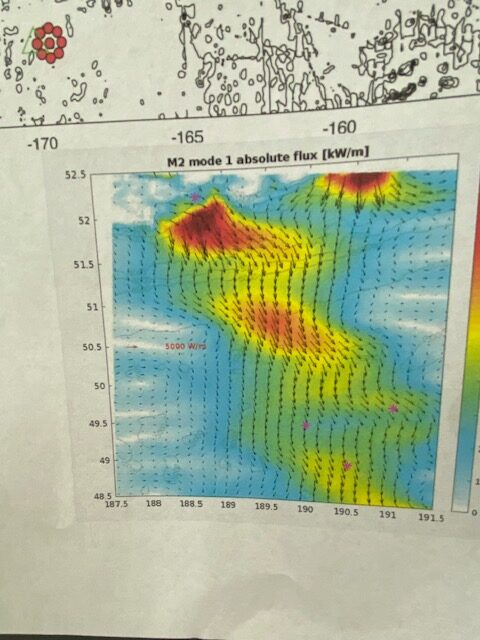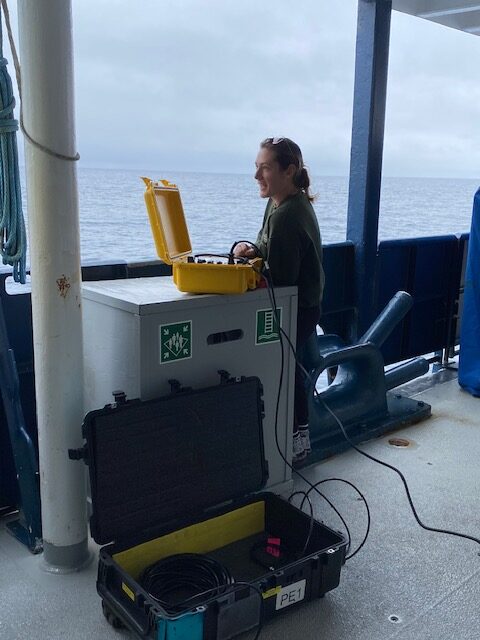(from right to left) SIO graduate students Caeli Griffin and Grant Meiners Chief-Scientists-in-the-making with R/V Atlantis Captain Derek discussing their night ops. (photo Magdalena Andres)
The IWR Array deployment is complete (with 8 CPIESs and the central full-water-column mooring in about 5300 m water depth)! It will be measuring the tidal beam that emanates from the Aleutian Islands for the next ~12 months, until we recover the array. We’re in the middle of the 5th of 6 REMUS dives and we’ve deployed two of the three SQUID floats (EM APEX).
After the AUV dive, we’ll head north to deploy Joe (UMD) and Vitalli’s (WHOI) Longline Array across the slope (300-900 m depths) to capture the internal wave generation. Looks like we’ll have another beautiful weather window for that deployment. After that, I will also deploy one of my CPIES (#9) just offshore of the Longline Array (in 3600 m) at 52N 171 W, where there is a hotspot of M2 mode 1 energy flux according to HYCOM (see our on-ship printed version courtesy of the NGIW HYCOM group).

The internal tide beam coming off the Aleutian slope – our guiding map for this cruise! Thanks HYCOM NGIW team members! (photo by Magdalena Andres)
With that we should have good coverage, both offshore (in the beam) and onshore (in the generation region). It’s super to be able to measure both the beam and the generation at once! From all initial accounts, the mooring is sending back beautiful near-real time data (CTD from the Wirewalker and subsurface mooring, and ADCPs).
After the Longline is deployed, the Greg and the rest of the WHOI AUV team will conduct the 6th REMUS dive for a closer look at the region around the Longline; we’ll be planning the details of that later this afternoon or tomorrow with Masako, Maurice, Sean and Joe K. We also hope to conduct a 25-hour ADCP/CTD yo-yo directly in the M2 hotspot (in the location of CPIES #9).
In between deployments and dives, we’ve been making use of shiptime doing the calibration CTDs at each of the IWR Array sites and conducting several ADCP/CTD yo-yo surveys (one million thanks to the CTD watches: Caeli, Grant and Maarten and Joe K., Joe F and Patrick). The students have been designing the ADCP/CTD surveys and have been working out the operations with the bridge. They’ve been making great middle-of-the-night decisions and communicating those with the bridge.
Helen Dufel, from the SIO MOD lab, is here checking the releases after the mooring deployment….after lots of trying and manoeuvring the ship and sacrificing to the acoustic-gods and persistence by Helen this was successful. (For all the other communications, we have been able to use the ship’s through hull transducer and that has worked really well — including to test the releases when they were attached to the rosette, but for some reason, this time we had to use the over the side transducer and orient the ship just right).

Warm Regards,
Magdalena

